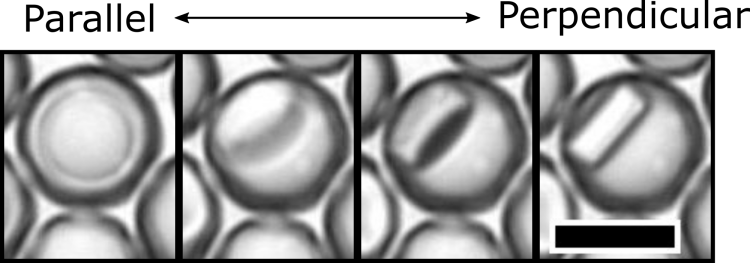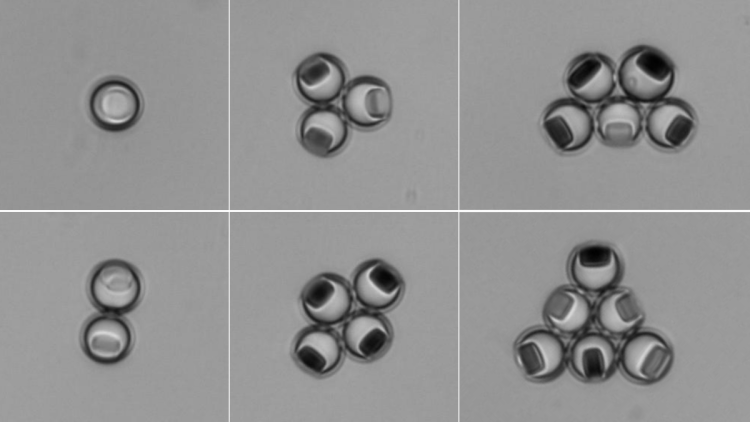Research on manipulating endoskeletal droplets with acoustic radiation published in Nature

Above: Gazendra Shakya (PhDMechEngr'21)
Header image: Different orientation of disks at 10 MHz of acoustic standing wave.
Research from the College of Engineering and Applied Science that uses acoustic radiation forces to shape the internal structure of suspended droplets has been published in Nature Communications.
The paper, titled “Acoustically Manipulating Internal Structure of Disk-in-Sphere Endoskeletal Droplets,” is a collaborative work completed by researchers in the Paul M. Rady Department of Mechanical Engineering, the Biomedical Engineering Program and the Materials Science and Engineering Program.
Their work could boost health and drug advancements by giving researchers a better understanding of primary and secondary radiation forces in multiphase colloidal systems – such as emulsions, foams, membranes and gels. Those forces are currently being studied for cell separation for disease diagnoses and drug delivery systems for cancer treatments.
First author Gazendra Shakya, a PhD graduate who worked in the labs of Professors Mark Borden and Xiaoyun Ding, shared how the group came to the more thorough understanding of radiation forces and how the research could benefit future studies.
Can you explain what endoskeletal droplets are and how you used them in this research?
Endoskeletal droplets are tiny liquid droplets that are suspended in an aqueous or water medium. The ones we used are 10 micrometers in diameter, a similar size to biological cells. For comparison, a typical human hair is 100 micrometers in diameter.
The interesting thing about these liquid droplets are that they have a solid skeleton embedded inside them, hence the name endoskeletal droplets. There are different types of endoskeletal droplets but the ones we study in this project have a disk-shaped solid inside the liquid droplet.

The disk-shaped endoskeletal droplets and their freedom of rotation inside the droplet.
What are the real-world impacts from this research? How will the collaborative work benefit society?
The radiation forces are very important in any colloidal system that deals with acoustic waves. For example, these forces are being studied currently for cell separation for disease diagnosis or optimizing drug delivery systems for cancer treatments. But these forces and their behaviors in multiphase colloidal systems have not yet been fully understood. With this current paper, we have gotten a better understanding of the primary and secondary radiation forces.
Moreover, this study demonstrated the possibility of manipulating internal structures of droplets and cells. This can pave the way to manipulating internal organelles in a cell, which is very challenging for current techniques, but could be helpful to understand the communication and function of intracellular organelles.
Is exploring the internal structure of a droplet this small challenging?
It is very challenging because the internal structure adds a lot of complexity. With that added internal phase, which has different physical and chemical properties, it is very hard to properly explore the behavior of the internal structure.
I think the geometry also played an important part. We have discovered the ideal droplet at the internal phase is not spherical. Instead, it is cylindrical like a flattened disk and free to rotate or move around inside the droplet. This was a major advantage for us because we could now visualize how different forces were affecting the internal structure as it moved and rotated in response.

Different cluster types and different orientations of disks inside the droplets. This is at a higher frequency of 20 MHz.
How did you use radiation forces to manipulate the structure within the droplet?
Currently, we are using acoustic frequencies which are in the MHz range and hence inaudible. Any particle in an acoustic field experiences a force called the acoustic radiation force. There are two types of radiation forces: the primary radiation force and the secondary radiation force. These two forces have different implications on suspended particles. Since we have particles with two different acoustic properties in a single droplet – liquid and solid properties – they both are affected in different ways.
The liquid droplet is pushed to a specific direction by the primary radiation force and the attractive force from the secondary radiation creates clusters. As for the solid disks inside the droplets, the primary radiation force pushes the disks to the top of the cluster and forces them to be parallel to the substrate, whereas the secondary radiation force pushes it to the edges of the cluster and makes them perpendicular. By manipulating the magnitude of these forces, which can be done by either changing the frequency or the cluster size, we could manipulate the internal structure of the disks.
The other authors on this paper include previous postdoctoral scholar Tao Yang, postdoctoral associate Yu Gao, PhD researcher Apresio K. Fajrial, and professors Baowen Li,Massimo Ruzzene, Mark A. Borden and Xiaoyun Ding.

